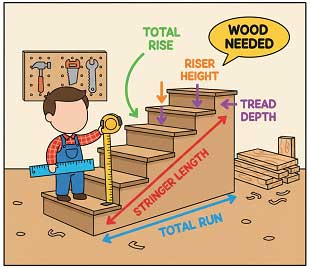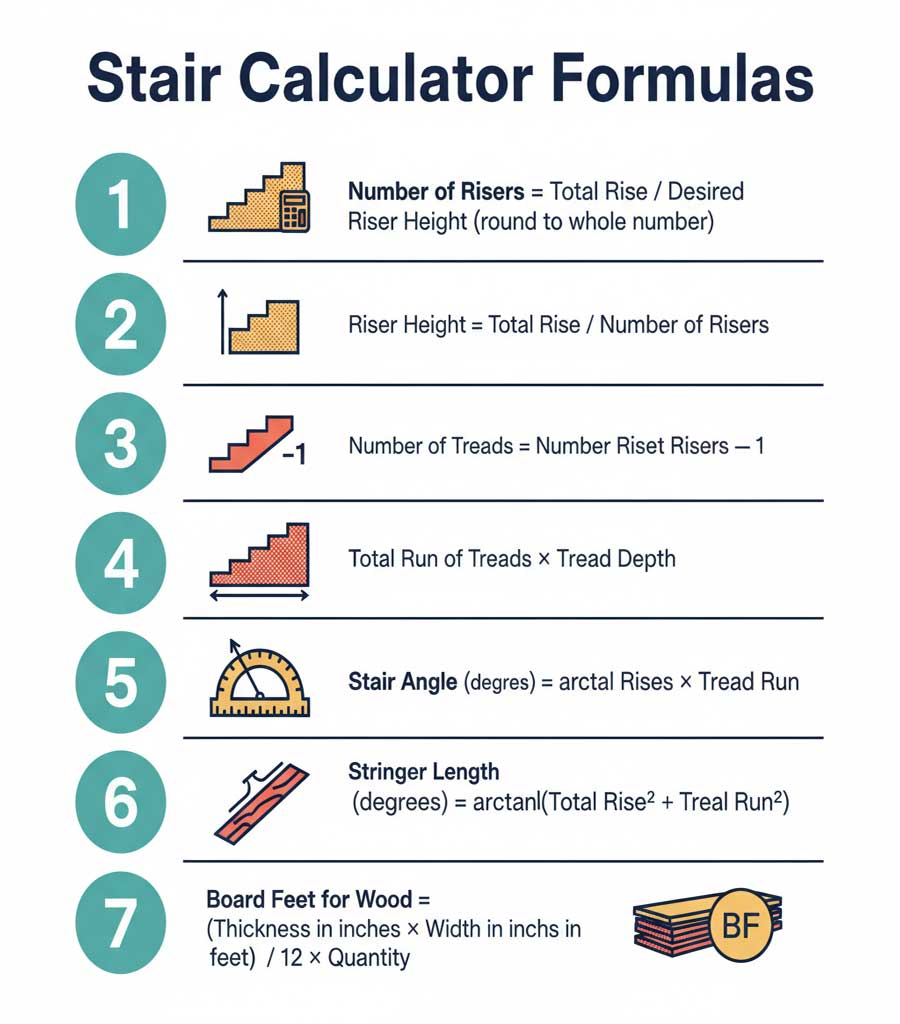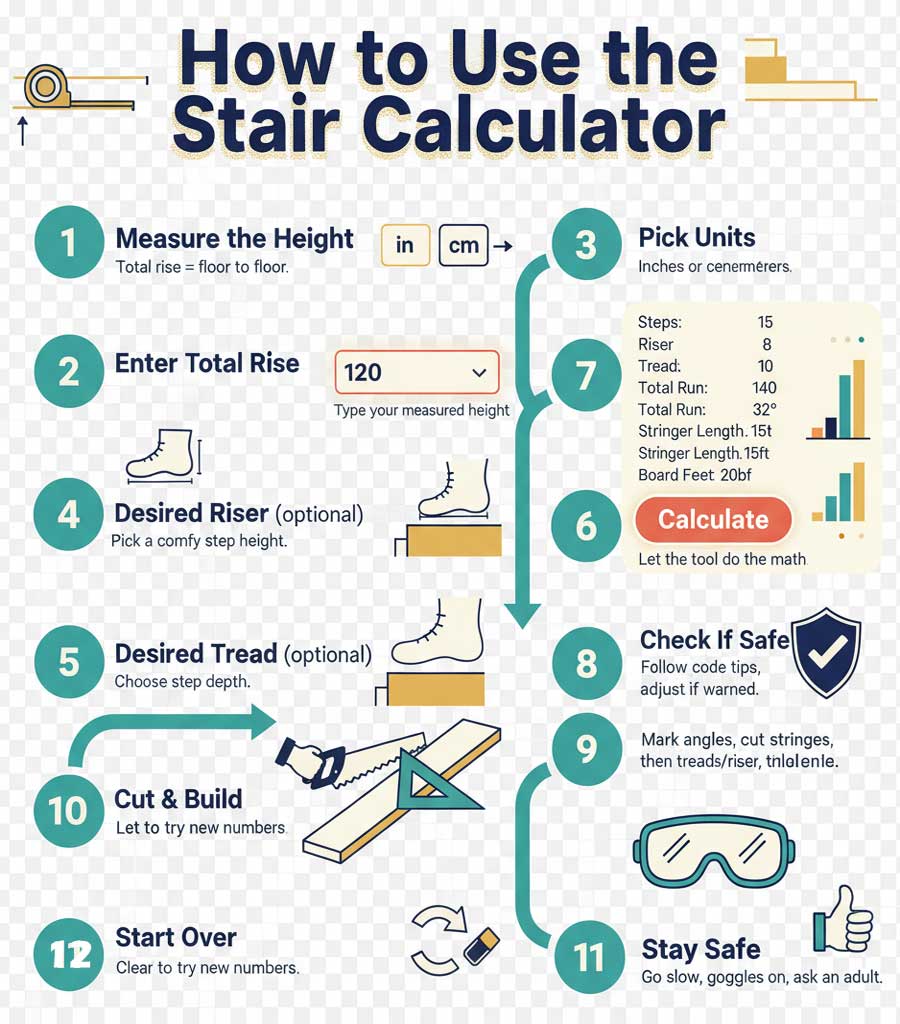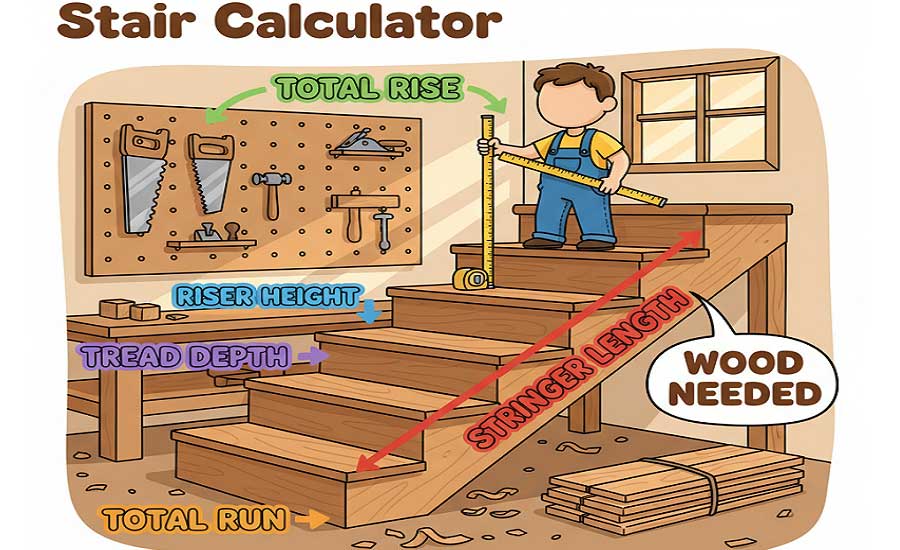Hey there, woodworker! Building stairs is like making a path up a hill with wood. It's fun but needs right steps so no one trips.
This Stair Calculator figures out step sizes for straight stairs. It takes ideas from many places to make it easy.
It adds what others forget like wood amount in board feet for buying lumber. It checks if steps are safe like rules say.
You enter height and it gives number of steps. Riser height. Tread depth. Angle. Stringer length. Even how much wood you need. Your stairs will be strong and comfy to climb!
Stair Calculator (Calculate Rise, Run, Stringer Length & Angle)

Another important calculator: Wood Measurements of Lumber in cft
The Formulas This Calculator Uses

This tool uses easy math rules to plan stairs.
Number of Risers = Total Rise ÷ Desired Riser Height (round to whole number).
Riser Height = Total Rise ÷ Number of Risers.
Number of Treads = Number of Risers - 1.
Total Run = Number of Treads × Tread Depth.
Stair Angle = arctan(Total Rise ÷ Total Run) in degrees.
Stringer Length = square root(Total Rise² + Total Run²).
Board Feet for Wood = (Thickness in inches × Width in inches × Length in feet) ÷ 12 × Quantity.
It checks rules: Riser 4 to 7.75 inches. Tread 10 inches min. Angle 30 to 37 degrees. These make stairs safe and comfy. Adjust if needed to fit rules.
Note: Best Free Cut List Optimizer Guide
How to Use the Calculator – Your Home Woodworking Guide!
Hey there, young woodworker! This calculator is your very own helper at home, like a friendly teacher right by your side. It’s super easy to use, and I’ll guide you step by step so you can measure and build stairs all on your own. Let’s get started and make safe stairs—safely and with lots of fun!

- Measure the Height Use a tape measure to find the total rise. That's the height from the bottom floor to the top floor. Measure straight up. Write it down in inches or cm.
- Pick Units Look at the "Units" box. Choose "Inches" or "Centimeters" to match your tape measure. This makes numbers right for you.
- Enter Total Rise Type the height you measured into the "Total Rise" box. This is the main number the calculator needs.
- Add Desired Riser if You Want If you have a favorite step height, type it in "Desired Riser Height." Like 7 inches. If not, leave it. The calculator picks a good one.
- Add Desired Tread if You Want Type a tread depth in "Desired Tread Depth" if you like. Like 10 inches. If not, the calculator chooses a safe size.
- Hit Calculate Press the "Calculate" button. This tells the calculator to do the math. It finds the best steps for you.
- See the Results Look at what pops up! It shows number of steps. Riser height. Tread depth. Total run. Angle. Stringer length. Wood needed in board feet. Read each part slow.
- Check if Safe See if it says "Safe" or warns about rules. If not safe, change numbers like rise or tread. Try again till it's good.
- Cut and Build Use the numbers to mark your wood. Set your saw to the angle. Cut stringers first. Then treads and risers. Put them together with nails or screws.
- Start Over if Needed Press "Clear" to wipe everything. Like a fresh start. Try new numbers for different stairs.
- Stay Safe Always Work slow. Keep fingers away from saw. Ask an adult to check if you're new. Wear goggles. Have fun building!
Read to know: Free Miter Angle Calculator : Precise Cuts for Woodworking
This is your own guide, like a teacher in your calculator. Practice these steps, and soon you'll make stairs like a pro—all by yourself!
Got it. I’ll write this like I’m explaining stairs to a curious friend—clear, practical, no jargon. Each question will get a straight-to-the-point answer first (good for snippets), then a breakdown with examples so it’s easy to digest. Here we go:
What is the 27 rule for stairs?
The 27 rule says the sum of one riser (the vertical part) plus one tread (the horizontal part you step on) should equal about 27 inches.
Think of it like this: if your riser is 7 inches, your tread should be around 10 inches. Add them up → 17. Wait, that’s too low. For 27, usually it’s closer to riser 7 + tread 10 + extra comfort adjustment = around 27. It’s basically a comfort formula so stairs feel natural, not too steep or too shallow.
How do you calculate how many stairs you need?
Divide the total height you need to climb by the height of one riser.
Example: If your floor-to-floor height is 10 feet (120 inches), and you want 7.5-inch risers → 120 ÷ 7.5 = 16 steps.
What is the perfect rise and run for stairs?
The sweet spot is 7-inch rise and 11-inch run.
That combo feels natural for most people’s stride. It’s called the “7-11 rule” (not the shop).
What is the 7-Eleven rule for stairs?
It means: riser height should be about 7 inches, tread depth about 11 inches.
This rule is used worldwide because it creates safe, comfortable stairs.
What is the golden rule for stairs?
Stairs should be easy enough for a child and safe for an older adult. Practically, that means riser height around 7 inches and tread depth around 10–11 inches.
What are common stair design mistakes?
- Making risers too tall (over 8 inches feels exhausting).
- Treads too narrow (less than 10 inches = your foot hangs off).
- Inconsistent riser heights (trip hazard).
- No handrail.
- Forgetting enough headroom → bumping your head!
What is the rule for calculating stairs?
Total rise ÷ riser height = number of steps.
That’s the golden formula.
How many floors of stairs are 1000 steps?
Roughly 50 floors.
Why? One floor = about 20 steps. 1000 ÷ 20 = 50.
What is the perfect ratio for stairs?
Riser + tread should equal around 17–18 inches.
Example: 7-inch rise + 11-inch tread = 18 → feels perfect.
How many stairs for 10 feet height?
Around 14–16 steps.
Because 10 feet = 120 inches. If risers are 7.5 inches → 16 steps.
What is the 25 rule for stairs?
Similar to the 27 rule, it means riser + tread = about 25 inches.
It’s another comfort formula used by some designers.
Is a 9 inch step too high?
Yes, 9 inches is too high.
That’s tiring, unsafe for kids or elderly. Standard is 7–7.5 inches.
Is an 8 inch stair riser too high?
Borderline. It’s allowed in some places, but still tiring compared to 7–7.5 inches.
What is the staircase paradox?
It’s a math problem: a staircase looks longer when you measure the steps individually compared to measuring straight across the diagonal. It’s like the classic “coastline paradox” but with stairs.
How to figure out your rise and run for stairs?
- Measure total height (floor to floor).
- Decide riser height (usually 7–7.5 inches).
- Divide total height by riser → get number of steps.
- Pick tread depth (usually 10–11 inches).
That’s your rise and run.
Stair Rules & Quick Reference
| Rule / Question | Straight Answer | Details / Example |
|---|---|---|
| 27 Rule | Riser + tread ≈ 27 inches | Comfort formula. Ex: 7″ riser + 10″ tread ≈ 17 (too low), so tread usually adjusted. |
| 25 Rule | Riser + tread ≈ 25 inches | Another version of comfort calculation. |
| 7-11 Rule | Riser ≈ 7″, tread ≈ 11″ | Most common safe + comfortable ratio. |
| Golden Rule | Easy for kids & safe for elderly | Usually means ~7″ rise and 10–11″ run. |
| Perfect Rise & Run | 7″ rise, 11″ run | Feels natural to walk on. |
| Perfect Ratio | Riser + tread ≈ 17–18 inches | Ex: 7″ rise + 11″ tread = 18″. |
| How to Calculate Stairs | Total rise ÷ riser height | 120″ ÷ 7.5″ = 16 steps. |
| 10 ft Height = ? Steps | About 14–16 steps | With 7–7.5″ risers. |
| 1000 Steps = ? Floors | ≈ 50 floors | One floor = ~20 steps. |
| Is 9″ Riser Too High? | Yes, unsafe | Hard on knees, tiring. |
| Is 8″ Riser Too High? | Borderline | Allowed in some places but less comfortable than 7–7.5″. |
| Common Mistakes | Too tall risers, too narrow treads, inconsistent sizes, no railing, low headroom | These make stairs unsafe or awkward. |
| Staircase Paradox | Staircase looks longer when measured step by step vs. diagonal | A geometry/measurement illusion. |
| How to Find Rise & Run | Measure total rise → divide by riser height → pick tread depth | Ex: 120″ ÷ 7.5″ = 16 steps, each tread ~11″. |


